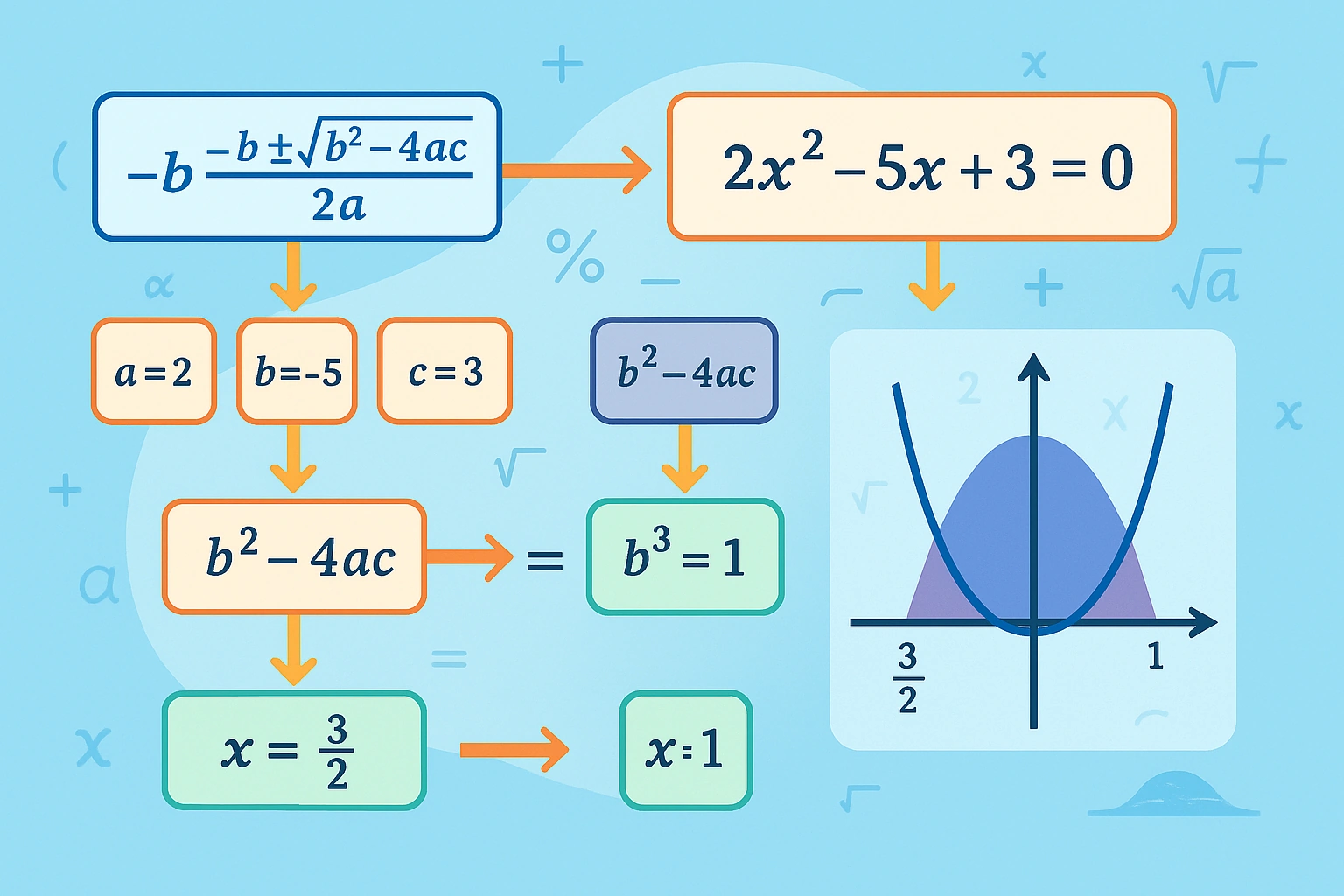Stuck on $x^2 - 5x + 6 = 0$ and can't figure out where to start? You're not alone. Quadratic equations show up everywhere in algebra—from projectile motion in physics to optimization problems in calculus. The good news? Once you understand the quadratic formula, these problems become straightforward.
This guide will walk you through everything you need to know about solving quadratic equations, with real examples you can follow step-by-step.
🎯 Try it now: Use our free interactive Quadratic Formula Calculator to solve quadratic equations instantly with discriminant analysis and step-by-step solutions.
💡 Pro tip: Before reaching for the quadratic formula, always check if you can factor the equation quickly. Factoring is faster when it works, but the quadratic formula works every time—even when factoring doesn't.
📋 Free Cheat Sheet: Need a quick reference? Get our Quadratic Equations Cheat Sheet with the quadratic formula, factoring patterns, and more.
📸 Ready to get unstuck? Try MathPad Free →
What is a Quadratic Equation?
A quadratic equation is any equation that can be written in the standard form:
$$ax^2 + bx + c = 0$$
Where:
- $a$, $b$, and $c$ are constants (numbers)
- $x$ is the variable we're solving for
- $a \neq 0$ (if $a = 0$, it's just a linear equation)
Examples of quadratic equations:
- $x^2 - 5x + 6 = 0$ (where $a=1$, $b=-5$, $c=6$)
- $2x^2 + 3x - 2 = 0$ (where $a=2$, $b=3$, $c=-2$)
- $x^2 - 9 = 0$ (where $a=1$, $b=0$, $c=-9$)
The term "quadratic" comes from "quad" meaning square—the highest power of $x$ is 2 (squared).
The Quadratic Formula
The quadratic formula is the most reliable method for solving any quadratic equation. Here it is:
$$x = \frac{-b \pm \sqrt{b^2-4ac}}{2a}$$
This formula might look intimidating, but it's actually just a recipe: plug in your values for $a$, $b$, and $c$, then calculate. The $\pm$ symbol means you'll get two solutions—one using addition ($+$) and one using subtraction ($-$).
The Discriminant: $b^2 - 4ac$
The expression under the square root, $b^2 - 4ac$, is called the discriminant. It tells you what type of solutions you'll get:
- Positive discriminant ($b^2 - 4ac > 0$): Two different real solutions
- Zero discriminant ($b^2 - 4ac = 0$): One repeated real solution
- Negative discriminant ($b^2 - 4ac < 0$): Two complex solutions (involving $i$)
Historical Context
The quadratic formula has been known for thousands of years. Babylonian mathematicians around 2000 BCE could solve quadratic equations geometrically. The Persian mathematician Al-Khwarizmi (c. 780–850 CE) gave us the word "algebra" and developed systematic methods for solving quadratics. The formula as we know it today was fully developed by Indian and Islamic mathematicians in the Middle Ages.
How to Use the Quadratic Formula (Step-by-Step)
Let's break down the process into simple steps:
Step 1: Identify a, b, and c
First, make sure your equation is in standard form: $ax^2 + bx + c = 0$
If it's not, rearrange it by moving all terms to one side.
Example: If you have $x^2 = 5x - 6$, rewrite it as $x^2 - 5x + 6 = 0$
Then identify:
- $a$ = coefficient of $x^2$
- $b$ = coefficient of $x$
- $c$ = constant term
Watch out for signs! If you have $x^2 - 5x + 6 = 0$, then $b = -5$ (not $+5$).
Step 2: Calculate the Discriminant
Before using the full formula, calculate $b^2 - 4ac$. This tells you what to expect.
Example: For $x^2 - 5x + 6 = 0$:
$$b^2 - 4ac = (-5)^2 - 4(1)(6) = 25 - 24 = 1$$
Since the discriminant is positive (1 > 0), we'll get two different real solutions.
Step 3: Apply the Formula
Plug your values into: $x = \frac{-b \pm \sqrt{b^2-4ac}}{2a}$
Calculate the two solutions:
- $x_1 = \frac{-b + \sqrt{b^2-4ac}}{2a}$
- $x_2 = \frac{-b - \sqrt{b^2-4ac}}{2a}$
Step 4: Simplify
Simplify the square root if possible, then reduce the fraction.
Let's see this in action with real examples.
Worked Examples
Example 1: Two Real Solutions
Problem: Solve $x^2 - 5x + 6 = 0$
Solution:
Identify coefficients: $a = 1$, $b = -5$, $c = 6$
Calculate discriminant: $$b^2 - 4ac = (-5)^2 - 4(1)(6) = 25 - 24 = 1$$
Since $1 > 0$, we'll get two real solutions.
Apply the formula: $$x = \frac{-(-5) \pm \sqrt{1}}{2(1)} = \frac{5 \pm 1}{2}$$
Find both solutions:
- $x_1 = \frac{5 + 1}{2} = \frac{6}{2} = 3$
- $x_2 = \frac{5 - 1}{2} = \frac{4}{2} = 2$
Answer: $x = 3$ or $x = 2$
Verification: Let's check $x = 3$: $$3^2 - 5(3) + 6 = 9 - 15 + 6 = 0$$ ✓
Example 2: One Repeated Solution
Problem: Solve $x^2 - 6x + 9 = 0$
Solution:
Identify coefficients: $a = 1$, $b = -6$, $c = 9$
Calculate discriminant: $$b^2 - 4ac = (-6)^2 - 4(1)(9) = 36 - 36 = 0$$
Since the discriminant is 0, we'll get one repeated solution.
Apply the formula: $$x = \frac{-(-6) \pm \sqrt{0}}{2(1)} = \frac{6 \pm 0}{2} = \frac{6}{2} = 3$$
Answer: $x = 3$ (repeated root)
Note: This equation can also be factored as $(x-3)^2 = 0$, which makes it clear that $x = 3$ is a double root.
Example 3: Complex Solutions
Problem: Solve $x^2 + 2x + 5 = 0$
Solution:
Identify coefficients: $a = 1$, $b = 2$, $c = 5$
Calculate discriminant: $$b^2 - 4ac = (2)^2 - 4(1)(5) = 4 - 20 = -16$$
Since $-16 < 0$, we'll get complex solutions.
Apply the formula: $$x = \frac{-2 \pm \sqrt{-16}}{2(1)} = \frac{-2 \pm 4i}{2}$$
Simplify:
- $x_1 = \frac{-2 + 4i}{2} = -1 + 2i$
- $x_2 = \frac{-2 - 4i}{2} = -1 - 2i$
Answer: $x = -1 + 2i$ or $x = -1 - 2i$
Note: Complex solutions always come in conjugate pairs: $a + bi$ and $a - bi$.
Example 4: Coefficient $a \neq 1$
Problem: Solve $2x^2 - 7x + 3 = 0$
Solution:
Identify coefficients: $a = 2$, $b = -7$, $c = 3$
Calculate discriminant: $$b^2 - 4ac = (-7)^2 - 4(2)(3) = 49 - 24 = 25$$
Apply the formula: $$x = \frac{-(-7) \pm \sqrt{25}}{2(2)} = \frac{7 \pm 5}{4}$$
Find both solutions:
- $x_1 = \frac{7 + 5}{4} = \frac{12}{4} = 3$
- $x_2 = \frac{7 - 5}{4} = \frac{2}{4} = \frac{1}{2}$
Answer: $x = 3$ or $x = \frac{1}{2}$
📸 Ready to get unstuck? Try MathPad Free →
Alternative Methods for Solving Quadratic Equations
While the quadratic formula always works, sometimes other methods are faster or more intuitive.
Method 1: Factoring
When to use: When the equation factors nicely (usually when $a$, $b$, and $c$ are small integers)
Example: $x^2 - 5x + 6 = 0$
Factor as: $(x - 2)(x - 3) = 0$
Set each factor to zero:
- $x - 2 = 0 \Rightarrow x = 2$
- $x - 3 = 0 \Rightarrow x = 3$
Pros: Fast when it works Cons: Not all quadratics factor nicely with integers
Method 2: Completing the Square
When to use: Good for understanding where the quadratic formula comes from; useful in calculus
Example: $x^2 - 6x + 5 = 0$
- Move constant to right: $x^2 - 6x = -5$
- Add $\left(\frac{b}{2}\right)^2$ to both sides: $x^2 - 6x + 9 = -5 + 9$
- Factor left side: $(x - 3)^2 = 4$
- Take square root: $x - 3 = \pm 2$
- Solve: $x = 3 \pm 2$, so $x = 5$ or $x = 1$
Pros: Always works; helps understand the formula Cons: More steps than the quadratic formula
Method 3: Graphing
When to use: To visualize solutions; to check your work
Plot $y = ax^2 + bx + c$ and find where it crosses the x-axis (where $y = 0$).
Pros: Visual understanding Cons: Only gives approximate solutions unless you have exact graph
Which Method Should You Use?
- Try factoring first (5-10 seconds). If it works, you're done.
- If factoring doesn't work, use the quadratic formula.
- Use completing the square if you need to understand the process or if you're deriving the quadratic formula.
- Use graphing to check your answer or get an approximate solution.
Common Mistakes to Avoid
Mistake 1: Sign Errors
Wrong: For $x^2 - 5x + 6 = 0$, using $b = 5$ instead of $b = -5$
Right: Always include the sign with the coefficient. If the term is $-5x$, then $b = -5$.
💡 Pro tip: Write out $a =$, $b =$, $c =$ with their signs before starting any calculation. This prevents 90% of sign errors.
Mistake 2: Forgetting the $\pm$ Symbol
Wrong: Only calculating $x = \frac{-b + \sqrt{b^2-4ac}}{2a}$ and missing the second solution
Right: Always calculate both:
- $x = \frac{-b + \sqrt{b^2-4ac}}{2a}$
- $x = \frac{-b - \sqrt{b^2-4ac}}{2a}$
Mistake 3: Discriminant Calculation Errors
Wrong: For $x^2 - 5x + 6 = 0$, calculating $b^2 - 4ac = 5^2 - 4(1)(6) = 1$ (forgetting $b = -5$)
Right: $b^2 - 4ac = (-5)^2 - 4(1)(6) = 25 - 24 = 1$
Remember: $b^2$ is always positive because you're squaring!
Mistake 4: Fraction Errors
Wrong: $\frac{6 \pm 2}{4} = \frac{6}{4} \pm \frac{2}{4}$ ❌ (you can't split the numerator like this)
Right: Calculate the numerator first: $\frac{6 + 2}{4} = \frac{8}{4} = 2$ and $\frac{6 - 2}{4} = \frac{4}{4} = 1$
Using MathPad's Quadratic Solver
While it's crucial to understand how to solve quadratics by hand, MathPad can help you master the process faster:
CAS-Verified Solutions (No AI Hallucinations)
Here's what makes MathPad different: Most AI math tools can make calculation errors. MathPad combines AI with a Computer Algebra System (CAS) that verifies every step mathematically before showing it to you.
When you photo a quadratic equation:
- Math-specific OCR reads your problem (not generic text recognition)
- AI proposes the solution method
- CAS verifies each algebraic step symbolically
- You get mathematically verified solutions, not AI guesses
This means no wrong answers, no arithmetic errors in the discriminant, no sign mistakes that pure AI might miss. Learn more about our accuracy approach →
How MathPad Helps You Learn
- Check your work instantly: Snap a photo of your problem and see if your answer matches
- Learn from step-by-step solutions: See every step of the quadratic formula process, CAS-verified
- Understand your mistakes: Use the Step Checker to compare your solution with the correct process
- Generate practice problems: Get unlimited quadratic equations to practice with
- Ask follow-up questions: AI Tutor answers questions like "Why did you choose the quadratic formula instead of factoring?"
Try solving quadratic equations in MathPad →
Practice Problems
Ready to test your skills? Try solving these quadratic equations. Start with #1-3, then challenge yourself with #4-5.
- $x^2 + 7x + 12 = 0$ (Hint: Try factoring first)
- $x^2 - 4x + 4 = 0$ (Hint: What's the discriminant?)
- $x^2 + 2x - 8 = 0$
- $3x^2 - 5x - 2 = 0$ (Hint: $a \neq 1$)
- $2x^2 + 4x + 5 = 0$ (Hint: Complex solutions)
Want instant step-by-step solutions for these problems? Solve them in MathPad and see detailed explanations for each step.
Frequently Asked Questions
What is the quadratic formula used for?
The quadratic formula solves any equation in the form $ax^2 + bx + c = 0$. It's used in physics (projectile motion, free fall), engineering (optimization problems), economics (profit maximization), and throughout higher mathematics. It's one of the most important formulas in algebra.
Do I need to memorize the quadratic formula?
Yes, you'll use it frequently enough in algebra, precalculus, and calculus that memorization is worthwhile. Many students remember it through rhythm or song. Focus on understanding what each part means ($-b$ shifts the vertex, $\pm$ gives two solutions, etc.) rather than just memorizing symbols.
Can all quadratic equations be solved with the quadratic formula?
Yes! The quadratic formula works for every quadratic equation, even when factoring is impossible or difficult. That's why it's so powerful—it's a universal method that never fails (as long as $a \neq 0$).
What if my answer has a square root that doesn't simplify?
That's perfectly fine! Not all quadratic solutions are neat integers. For example, $x = \frac{3 \pm \sqrt{5}}{2}$ is a complete, exact answer. You can leave it in this form or use a calculator to get decimal approximations ($x \approx 2.618$ or $x \approx 0.382$).
How do I know if I should use + or - in the $\pm$ symbol?
You use both! The $\pm$ means you calculate two separate answers—one using $+$ and one using $-$. Most quadratic equations have two solutions, and the quadratic formula gives you both at once.
What does it mean when the discriminant is negative?
When $b^2 - 4ac < 0$, you'll get complex (imaginary) solutions involving $i$ (where $i = \sqrt{-1}$). This means the parabola doesn't cross the x-axis. Complex solutions are important in advanced math and engineering, even though they don't correspond to real-number x-intercepts.
Can I use the quadratic formula if $b = 0$ or $c = 0$?
Yes! The formula still works. If $b = 0$: $ax^2 + c = 0$ becomes $x = \pm\sqrt{-c/a}$. If $c = 0$: $ax^2 + bx = 0$ factors as $x(ax + b) = 0$, giving $x = 0$ or $x = -b/a$. But using simpler methods is faster in these cases.
How can I check if my quadratic solution is correct?
Plug your answer back into the original equation. If you get 0, your solution is correct. For example, if $x = 3$ solves $x^2 - 5x + 6 = 0$, then $3^2 - 5(3) + 6 = 9 - 15 + 6 = 0$ ✓
Is using a quadratic calculator cheating?
Using calculators as learning tools isn't cheating—it's smart studying. The key is to try problems yourself first, then use tools like MathPad to check your work and understand mistakes. Copying answers without learning the process will hurt you on tests, but using step-by-step solutions to learn is how you master the material.
✨ Start solving smarter Try Free →
Related Topics
Want to learn more about quadratic equations and related concepts? Check out these guides:
- Algebra Calculator with Steps - Master foundational algebra concepts
- Derivative Calculator with Steps - Learn calculus differentiation
- Khan Academy: Quadratic Equations - Video lessons and practice
- See all MathPad features - Explore AI Tutor, Step Checker, and more
Conclusion
The quadratic formula is one of the most powerful tools in your algebra toolkit. While it might seem complex at first, it's really just a systematic way to find where a parabola crosses the x-axis. With practice, you'll be able to identify $a$, $b$, and $c$ and plug them into the formula almost automatically.
Remember: understanding why the formula works is just as important as knowing how to use it. That understanding will help you in calculus, physics, and beyond.
If you want to practice quadratic equations with instant feedback and step-by-step explanations, try MathPad's free version and see how AI-powered tutoring can help you master the concept.
Have questions about quadratic equations? Contact our team or start solving problems at mathpad.ai/app.




